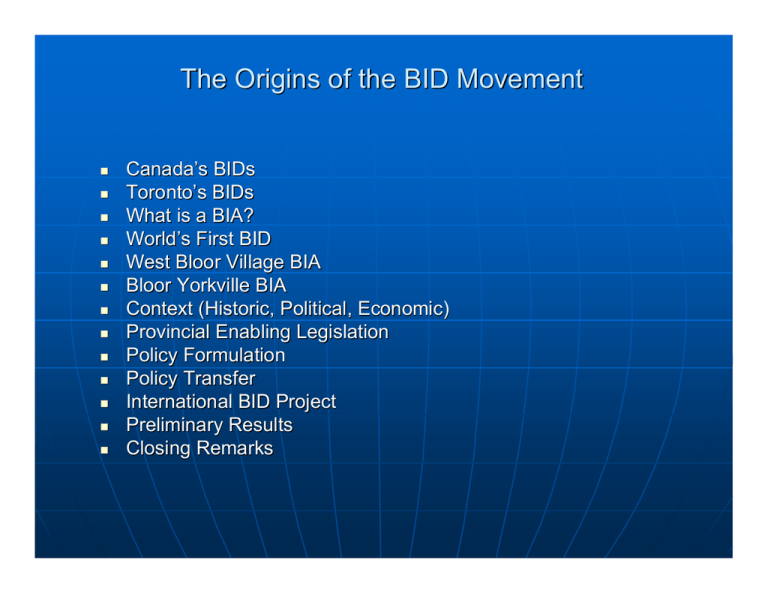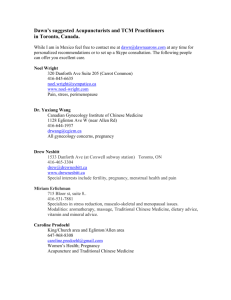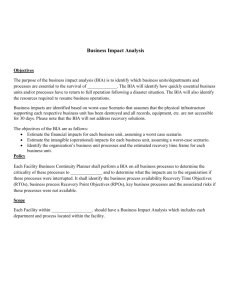The Origins of the BID Movement
advertisement

The Origins of the BID Movement Canada’s BIDs Toronto’s BIDs What is a BIA? World’s First BID West Bloor Village BIA Bloor Yorkville BIA Context (Historic, Political, Economic) Provincial Enabling Legislation Policy Formulation Policy Transfer International BID Project Preliminary Results Closing Remarks Canada’s BIDs (Business Improvement Areas) More than 230 BIAs in the Province of Ontario There are approximately 300 BIAs in Canada Toronto’s BIDs BIDs (Business Improvement Areas) Areas) Today there are 42 BIAs within the City of Toronto The combined annual budget is more than $4.2 million (or $2.8) City's BIAs have a total membership of nearly 6,000 businesses These businesses employ approximately 450,000 people They pay close to $100,000,000 in realty/business taxes to the City Partner with City in an annual $5 million, 50/50 cost-sharing program Organize events that generate over $2.1 million in sales Contribute more than 21,000 hours of volunteer time time Represent commercially assessed properties with value of $4 billion What is a BIA? An association of business people within a specified district Unite with official approval from the City Operate a self-help program aimed at stimulating local business Focus on attracting prospective customers to their area Improve the attractiveness and promote the area Once approved, membership is compulsory Seek to benefit adjacent neighborhoods and the City World’s First BID BID Bloor West Village (WBV) BIA By early 1920s Bloor Street was paved and double tracked By 1960s streetcars delivered visitors to this thriving commercial area Opening of several regional malls and completion of the subway line Bloor-Jane-Runneymede Business Men’s Association (voluntary) Committee formed and drafted legislation (w/support from local govt) Proposed a self-imposed tax on local business and property owners In May, 1970, the City of Toronto passed By-law No. 170-70 Ontario Municipal Board approved the Bloor-Jane-Runnymede BIA Focused on streetscape improvements and special events Today, WBV BIA is a vibrant neighborhood oriented commercial area West Bloor Village Village West Bloor has approximately 400 members member (Annual budget of $279,000) Administration = $5,000 Advertising and Promotion = $124,000 Maintenance = $100,000 (tree lighting and decorations, flower planting, boxes and benches, snow clearing, flags and banners) Capital Improvement 50/50 with City= $50,000 West Bloor Village - 2002 Runnymede/Bloor West Neighborhood Western Portion of Toronto Middle class neighborhood 1991 population = 24,256 Community Services Public Health, Neighborhood Profiles 1997 1997 “Looking Ahead: The Story of Ward One and Its Businessmen Looking Ahead in 1968” Boytchuk, William. Bloor West Villager (May 1971) No. 5, Vol. 4, Page 2 “Our problem was the quality of life on Bloor Street, the nature of the environment, and the necessity of assuring that life in the area did not deteriorate in the face of the onslaught of the Bloor Street subway and the ensuing threats to our residential neighborhoods and commercial districts. Confronted with these formidable issues, the members of the Bloor-Jane-Runnymede Businessmen’s Association and local politicians reached the eminently simple and sensible conclusion that all change does not have to be for the worse.” “The members of the businessmen’s association set about to achieve what they knew was possible. In 1968, they drafted legislation which they presented to City Hall asking that both sides of Bloor Street from Glendonwynne Road to South Kingsway, be designated as an improvement area. They quickly won the politicians to their side and their recommendations were heartily endorsed by both the City and Provincial Governments.” “Looking Ahead: The Story of Ward One and Its Businessmen Looking Ahead in 1968” “The legislation became a model that many other areas of the City are now trying to follow. Among other things, it provided for the area to the extent that the quality of life for those who both lived and shopped there was considerably enhanced. Trees were planted, benches installed, objectionable signs removed and many other changes effected. The process continues. Shopping on Bloor Street was always a pleasant experience, now it is absolutely groovy and should improve.” “To whom do we owe the credit? To our merchants and businessmen of course! As well as proposing the improvements, they also proposed to foot the bill themselves. Is it possible that someone went to City Hall asking permission to do something and offer to pay for it on their own? Our men did and the cost of all these improvements is added to their business tax bill every year through a special arrangement made with the city. The area now has a bright new name to complement its image, “the Bloor West Village.” It belongs to the residents of Ward One who should enjoy it and patronize the businesses that made it possible. After all, there are other parts of the city that want one like it.” “Merchants Upset with Street Vendors” October 1985, The Bloor West Villager Merchants complain that street vendors are stealing business Started with hot dog vendors and jewelry stands Fear that an influx of other types of vendors will occur “It’s just not right that they can come in here like that. They don’t pay the high rent.” “They don’t pay taxes or put money into the BIA. They get the benefits of our work into the area without paying.” “Thirty Years Later” August 1998, The Bloor West Villager “My family and I have been shopping in Bloor West Village for two decades. For me the village has everything you could possibly want all crowed into tightly delineated and walk able, shopping area two thirds of a mile long between High Park and the Humber River.” “Fresh butcher shops, European bakeries, neighborhood pharmacists, book stores, quality grocery stores, kid’s stores, doctors, dentists, veterinarians, a public library, movie theaters, video stores, ice cream stores, restaurants and coffee shops.” “Chapters Book Store is replacing the Bingo Theatre and the Body Shop recently rented space on the corner. Outsiders are driving up the neighborhood rents and pushing the Mom and Pop stores out.” Bloor Yorkville BIA Bloor-Yorkville is Toronto's largest BIA 2,500+ members and an annual budget of over $1 million Dovercourt Village is its smallest BIA (42 members, budget of $5,000) Bloor-Yorkville BIA was founded in July 1985 It has 21 Board Members Full-time, salaried General Manager Full-time BIA Staff Several management committees Bloor Yorkville Web Site The Origins of the BID Movement Canada’s BIDs Toronto’s BIDs What is a BIA? World’s First BID West Bloor Village BIA Bloor Yorkville BIA Context (Historic, Political, Economic) Provincial Enabling Legislation Policy Formulation Policy Transfer International BID Project Preliminary Results Closing Remarks Context Context (Historic, Political, and Economic) Economic) By 1971, 1 of every 3 Canadians lived in Montreal/Toronto/Vancouver These cities experienced a 90% increase from 1951 to 1971 Year 1901 1921 1941 1961 1981 1991 Total Total Population* Population* 5,371 5,371 8,788 8,788 11,507 11,507 18,232 18,232 24,343 24,343 27,296 27,296 *In thousands (Census of Canada) Urban Population 2,014 4,352 6,271 12,700 18,346 21,008 % Urban 37.5 49.5 54.5 69.6 75.5 77.0 Context Context (Historic, Political, and Economic) Economic) Mid-1940s Toronto was a bland metropolis with a manufacturing economy Population and jobs grew in cities at phenomenal rate Federal initiatives to redevelop downtowns devolve to Provincial level Increased demands for housing and consumer goods, services, education, health care, etc. etc. Postwar immigrants intensify growth and demand demand 1950s Cities grew and spread Shifts to suburbs as government facilitates low density development Context (Historic, Political, and Economic) 1960s Growth of auto sector and widespread use of the automobile Rapid suburbanization affects downtown Low growth rates in retail sales/Increased demand for public services 1970s 1970s Manufacturing relocates to urban fringe Leaders recognize the rapid decline of inner-city areas in many US cities Provincial authorities reinvest in old inner-city shopping districts 1980s Sharp rise in unemployment State spending at all levels decreases Context Context (Historic, Political, and Economic) Economic) 1990s In the postwar period, scholars call Toronto the “city that works” Did not experience the social/economic disparities of other cities It transformed into the dominant financial and industrial center Reputation as a vibrant city-region with a safe and diverse urban core Provincial Enabling Legislation Section 217 of the Municipal Act Empowers BIA members to use their own money (1) to promote their BIA and (2) to make physical improvements to their area in order to attract more customers Mandates organizational and operational issues issues Provincial Enabling Legislation Legislation “A local municipality may designate an area as an improvement area and establish a board of management, to oversee the improvement, beautification and maintenance of municipally-owned land, buildings and structures in the area beyond that provided at the expense of the municipality generally; and to promote the area as a business or shopping area.” “A board of management is a corporation consisting of the number of directors established by the municipality.” “A board of management shall not, spend any money unless it is is included in the budget approved by the municipality, incur any any indebtedness extending beyond the current year without the prior approval of the municipality.” A board of management shall submit its annual report that includes audited financial statements BIA Members consist of persons who are assessed Each member of an improvement area has one vote




